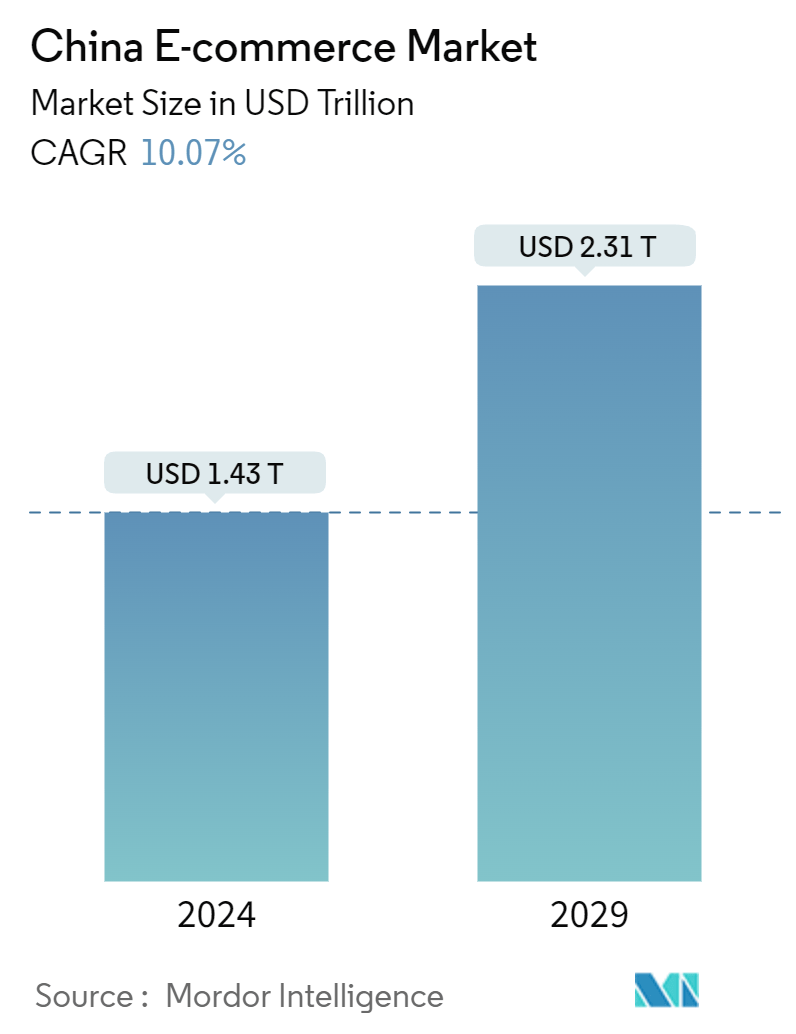Market Size of China E-commerce Industry

| Study Period | 2019 - 2029 |
| Base Year For Estimation | 2023 |
| Market Size (2024) | USD 1.43 Trillion |
| Market Size (2029) | USD 2.31 Trillion |
| CAGR (2024 - 2029) | 10.07 % |
| Market Concentration | High |
Major Players
*Disclaimer: Major Players sorted in no particular order |
China E-commerce Market Analysis
The China E-commerce Market size is estimated at USD 1.43 trillion in 2024, and is expected to reach USD 2.31 trillion by 2029, growing at a CAGR of 10.07% during the forecast period (2024-2029).
- The primary factors driving the growth of the e-commerce market in the region are smartphone-driven m-commerce culture, innovative digital payment systems, and rising live-commerce platforms, among others.
- With a vast population, the Chinese e-commerce market is the world's largest. The Chinese E-commerce market evolved rapidly during the past few years, primarily driven by high Internet and smartphone penetration, increased consumer confidence in online shopping, the emergence of e-commerce platforms, and various alternative payment solutions.
- Alternative payment solutions were the primary beneficiary of rising e-commerce purchases. Payment solutions such as Alipay and WeChat Pay are rapidly growing for e-commerce platforms. Alipay is a primary payment tool on all the e-commerce platforms owned by the Alibaba Group. On the other hand, WeChat Pay, which is offered by Tencent, leverages its massive social media user base to push online payments. As Chinese customers continue to embrace e-commerce, these payment solutions are expected to gain momentum.
- An inconvenient and often confrontational in-person shopping culture helped motivate shoppers in the region to embrace the straightforward reliability of e-commerce platforms. Also, they are easy to use in various shopping activities for making returns and securing refunds for online orders. Moreover, the low-cost delivery services provided by China's millions of migrant laborers enable companies like JD.com and Alibaba Group to provide same-day delivery anywhere in the country.
- While supportive policies exist, e-commerce players continue to face regulatory hurdles. Notably, strict regulations on data localization and personal data protection pose challenges, especially for non-Chinese companies planning to enter the market. The “Great Firewall of China” is described by the Chinese Communist Party (CCP) as a series of digital policies. The CCP introduced its own consumer data laws, notably the Personal Information Protection Law and Data Security Law. These regulations pose challenges for US firms looking to enter the Chinese market.
- The COVID-19 pandemic drove online shopping sales, even in rural areas, with the government investing in improving digital infrastructure in less developed regions. Post-pandemic, the number of e-commerce categories, such as groceries, health products, and home essentials, grew, which were previously dominated by the fashion and electronic categories.
China E-commerce Industry Segmentation
E-commerce refers to any form of business transaction conducted online or over the Internet. The most common example of e-commerce is online shopping, which is defined as the buying and selling of goods or services via the Internet on any device.
The Chinese e-commerce market is segmented by B2C e-commerce (beauty and personal care, consumer electronics, fashion and apparel, food and beverage, and furniture and home) and B2B e-commerce. The market sizes and forecasts are provided in terms of value (USD) for all the above segments.
| By B2C E-commerce | ||||||||
|
China E-commerce Market Size Summary
The China E-commerce market stands as the largest globally, driven by factors such as the widespread adoption of smartphones, innovative digital payment systems, and the rise of live-commerce platforms. The market has experienced rapid evolution due to high internet and smartphone penetration, increased consumer confidence in online shopping, and the emergence of various e-commerce platforms. Alternative payment solutions like Alipay and WeChat Pay have significantly contributed to this growth, leveraging their extensive user bases to facilitate online transactions. The convenience of e-commerce, including easy returns and refunds, along with low-cost delivery services, has further encouraged consumers to shift from traditional shopping to online platforms. However, the market faces challenges from stringent local e-commerce laws and intellectual property enforcement, which require companies to navigate complex takedown procedures for infringing content.
The COVID-19 pandemic has accelerated e-commerce activities as consumers turned to online shopping to avoid exposure to the virus, leading to increased purchases of groceries and physical goods. Livestreaming has emerged as a popular e-commerce format, allowing brands to reach broader audiences, particularly in rural and lower-tier cities, enhancing brand awareness and customer engagement. Major players like Alibaba's Taobao, JD.com, and newer entrants such as Douyin and Kuaishou have capitalized on this trend, integrating live commerce into their sales strategies. The market's growth is further supported by significant online shopping events like Singles' Day, which drive consumer engagement and sales. The presence of major companies such as Alibaba Group, JD.com, and Pinduoduo Inc. underscores the market's consolidation, with these players expanding their influence through strategic partnerships and acquisitions to enhance their market share and service offerings.
China E-commerce Market Size - Table of Contents
-
1. MARKET INSIGHTS
-
1.1 Market Overview
-
1.2 Industry Attractiveness - Porter's Five Forces Analysis
-
1.2.1 Bargaining Power of Suppliers
-
1.2.2 Bargaining Power of Buyers/Consumers
-
1.2.3 Threat of New Entrants
-
1.2.4 Threat of Substitute Products
-
1.2.5 Intensity of Competitive Rivalry
-
-
1.3 Key Market Trends and Share of E-commerce of Total Retail Sector
-
1.4 Impact of COVID-19 on the E-commerce Sales
-
-
2. MARKET SEGMENTATION
-
2.1 By B2C E-commerce
-
2.1.1 Market Segmentation - by Application
-
2.1.1.1 Beauty and Personal Care
-
2.1.1.2 Consumer Electronics
-
2.1.1.3 Fashion and Apparel
-
2.1.1.4 Food and Beverages
-
2.1.1.5 Furniture and Home
-
2.1.1.6 Others (Toys, DIY, Media, etc.)
-
-
-
2.2 By B2B E-commerce
-
China E-commerce Market Size FAQs
How big is the China E-commerce Market?
The China E-commerce Market size is expected to reach USD 1.43 trillion in 2024 and grow at a CAGR of 10.07% to reach USD 2.31 trillion by 2029.
What is the current China E-commerce Market size?
In 2024, the China E-commerce Market size is expected to reach USD 1.43 trillion.

